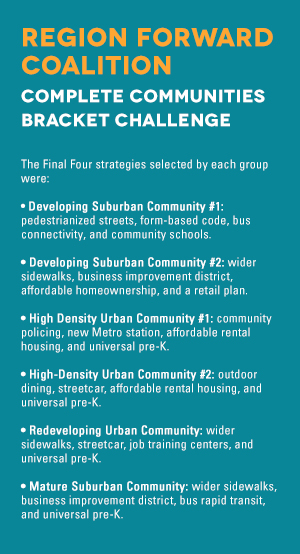Should a county put in a new Metrorail station or build a streetcar? Should a city allow for taller buildings in certain areas or implement a form-based code? Should a town promote affordable housing to buy to rent or both?
These are some of the investment choices that Region Forward Coalition members debated during their April 26 meeting that focused on the currently-under-development Activity Center Strategic Investment Plan. The Plan which is based on an analysis of the physical economic and social characteristics of Activity Centers in metro Washington is designed to help communities determine the investments that will be most effective in enhancing their strengths and addressing weaknesses.
To illustrate the process of selecting and prioritizing investments based on the context of each Center Coalition members participated in an interactive group exercise modeled on the NCAA Tournament in which they filled out a “Complete Communities Bracket.” (Atlantic Cities recently did a similar exercise—the Urbanist Bracket Challenge.)
Each group was assigned one of four general “types” of Activity Centers: High-Density Urban (e.g. Clarendon NoMA Silver Spring) Redeveloping Urban (Anacostia Potomac Yard West Hyattsville) Developing Suburban (Urbana Reston Town Center Westphalia) and Mature Suburban (Manassas Takoma Park Kensington).
 Like the March Madness bracket on which it is based the exercise requires participants to make a series of decisions choosing one winner at a time from a matchup of two different investments such as the creation of a Business Improvement District (BID) versus launching a business incubator or building a new recreational center or starting a public clinic.
Like the March Madness bracket on which it is based the exercise requires participants to make a series of decisions choosing one winner at a time from a matchup of two different investments such as the creation of a Business Improvement District (BID) versus launching a business incubator or building a new recreational center or starting a public clinic.
Beginning with a round of 32 unique investments across four different categories (Place Economy Social Equity and Economic Equity) the selection of “winners” led to the “Sweet 16” round the “Elite 8” and finally the Final Four of investments chosen for each particular type of Center.
Coalition members had lively conversations in the process of making difficult decisions between competing investments. When deciding between a new park and community policing for example one of the High-Density Urban groups decided that safety was a prerequisite for successful parks. The Redeveloping Urban group decided that the investments in the Economic Equity category were by far the most challenging to decide because economic equity was the most pressing need for that type of community. One of the Developing Suburban groups thought that the presence of a BID would be critical economically but also that the “innovative combination of school and community center” would provide the foundation for long term equity.
While this exercise certainly involves a highly simplified view of the complex work of place-making and economic development it helps participants think through and debate priorities and trade-offs when determining which investments will be best for each type of community.
Header photo (Downtown Rockville MD) credit: Bettercities.net